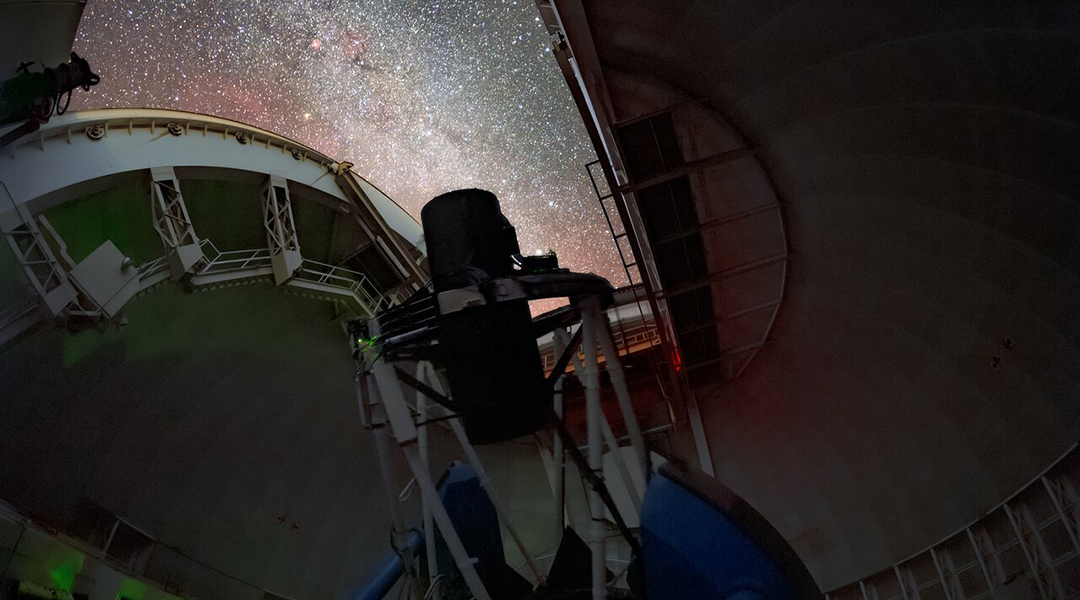An early release of data from the Dark Energy Spectroscopic Instrument (DESI) located at Kitt Peak National Observatory has revealed almost two million cosmic objects. The DESI data includes a cornucopia of galaxies, stars, and quasars, which may have been seen before, but not in the spectra of light astronomers need to intensely study the expansion of the Universe.
The early data comes from 2480 exposures taken during DESI’s six-month experimental run or “survey validation” phase conducted in 2020 and 2021. It serves as powerful proof of hoe vital the instrument will be for astronomers who are seeking to understand some of the most pressing cosmic mysteries. Scientists will primarily use it to better understand the accelerating expansion of the Universe, driven by a mysterious force called dark energy.
“The Dark Energy Spectroscopic Instrument is a ground-based four meter telescope equipped with 5000 robotic fibre positioners and ten spectrographs, designed to map the 3D position of 40 million quasars and galaxies to study dark energy,” said DESI co-spokesperson and scientist at Berkeley Lab, Nathalie Palanque-Delabrouille.
She added that this data release shows that over its five years of operations, of which three years remain, DESI will not just allow astronomers to study dark energy by mapping the large-scale structure of the cosmos and using the stretching of light, known as redshift, to see how rapidly distant galaxies are moving away from us, but it will also facilitate the investigation of other aspects of the Universe, such as dark matter, gravitational lensing, and the morphology of galaxies.
DESI is currently the only instrument of the new generation of “stage-IV dark energy instruments’ in operation. Palanque-Delabrouille pointed out that this makes the first public release of DESI data a major milestone for the collaboration.
“Although the release only consists of data taken during the commissioning of the instrument and the phase of validation of the survey, it contains close to two million objects,” she continued. “It also contains measurements over 140 square degrees of the sky — 1% of the full DESI survey — with science-grade data and even denser coverage of the sources in that area than what will be achieved during the rest of the DESI survey.
“We confirm that DESI is performing as expected, even slightly better than expected. So the full five-year survey is expected to reach and exceed its goal!”
This promising initial data release was also accompanied by a set of fifteen scientific papers. A portion of the DESI release is available to view as part of a searchable database curated by the Astro Data Lab at the Community Science and Data Center and the new SPectral Analysis and Retrievable Catalog Lab (SPARCL).
What is in the DESI release?
Astro Data Lab’s spectroscopic science lead, astronomer Stephanie Juneau, detailed some of the remarkable things that can be seen in this initial data.
“The DESI early data have been used to uncover a mass migration of stars in the Andromeda Galaxy, a large neighbour of the Milky Way,” she said. “The DESI observations revealed the movement of stars in a way that allowed us to trace back where they came from to assemble into the present shape of Andromeda, somewhat reconstructing its history.”
“The DESI data also include signatures of active black holes in galaxies spanning a range of the most extreme phenomena. We’re finding some of the most luminous quasars [feeding supermassive black holes] and some of the most distant quasars,” she continued.
Juneau added that despite being part of a medium-sized, four-meter telescope, DESI has been able to spot distant quasars that date all the way to when the Universe was less than a billion years old, meaning that their light has traveled nearly 13 billion years before reaching us.
She added that, in addition to this, DESI is also helping probe a more elusive and “quieter” population of black holes.
“DESI is revealing some of the elusive population of intermediate-mass black holes that bridge the gap between ‘ordinary’ giant black holes and the small stellar mass black holes,” Juneau said. “Those are key to understanding how giant black holes formed, starting from black hole seeds in the early Universe to today, but yet have largely remained elusive due to technical difficulties in teasing their spectroscopic signals in the data. Luckily, both DESI’s spectral resolution and sensitivity are helping us to circumvent these challenges.”
What makes DESI so special?
DESI is different from other telescopes. “The observing procedure itself is very ingenious in the sense that the DESI team developed sophisticated software to measure the quality of the data as it comes in and adjust the integration time of the next exposure to be longer or shorter as needed depending on the observing conditions,” Juneau said. “This way, the time spent is fully optimized, and no extra seconds are wasted. When there are enough photons from an exposure, the telescope moves on to the next one, and so on.”
This, Juneau added, also means that the resulting observations will be uniform across over a third of the entire sky, which DESI will be capable of observing.
“DESI is continuing to gather spectra at its impressive pace reaching up to 100,000 spectra per night under good conditions,” she said. “It has already obtained more than 26 million spectra, and if you’re reading this during night-time in Arizona, it’s getting 5000 new spectra every 20 minutes or so.”
The DESI collaboration is currently hard at work analysing the year-one data for measurements like the large-scale clustering of galaxies and different tracers of the cosmic structures, such as populations of galaxies and quasars spanning different times in the history of our 13.8-billion-year-old Universe.
“While the ultimate sub-per cent precision measurements will come at the end of the survey, we anticipate exciting first measurements in the coming year,” Juneau concluded.

















